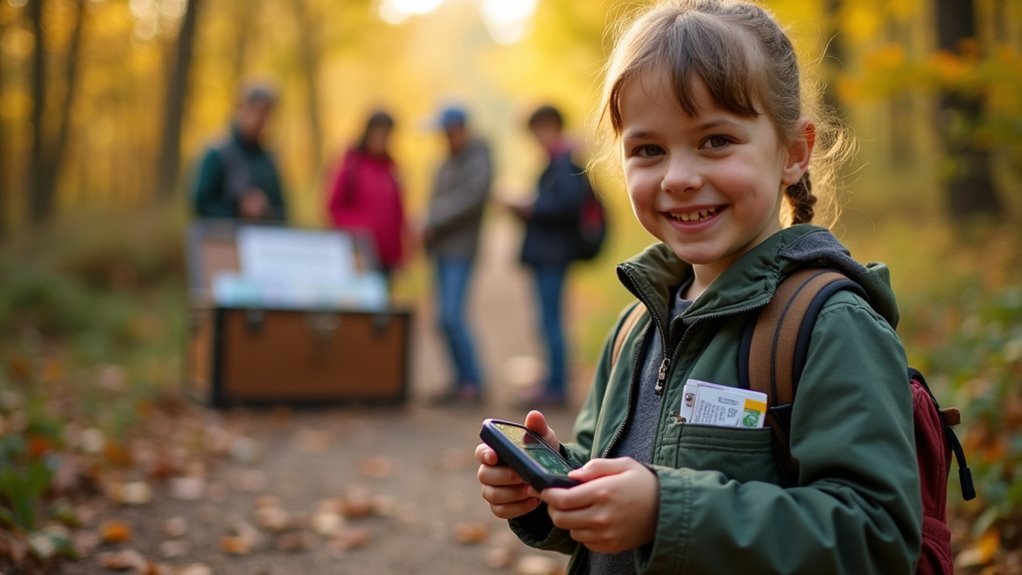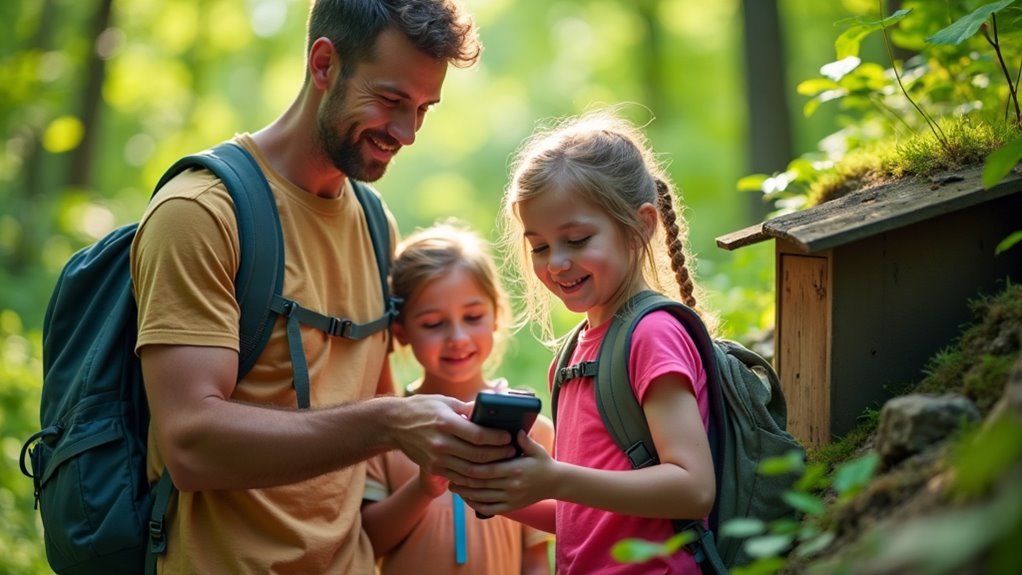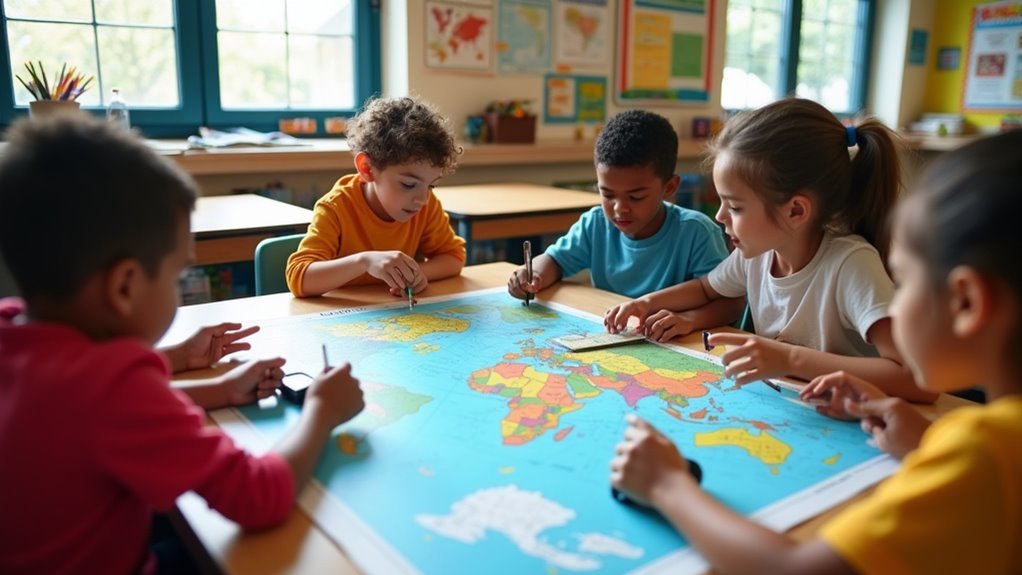Some of the links in this article may be affiliate links. If you make a purchase through these links, we may earn a small commission at no extra cost to you. Thank you.
I’ve always believed that education works best when kids don’t realize they’re learning. That’s why I’m such a fan of geocaching with students. Imagine their excitement when math and geography transform into a real-world treasure hunt! I’ve seen even my most reluctant learners light up when handed a GPS device. What makes this outdoor adventure so powerful for developing young minds? Well, it’s not just about finding hidden containers—it’s about what happens along the journey.
What Makes Geocaching an Educational Powerhouse

Why is geocaching such a powerful educational tool?
I’ve seen firsthand how it transforms ordinary lessons into adventures.
When kids use coordinates and maps to find hidden treasures, they’re actually mastering geography curriculum concepts without realizing it.
Geocaching transforms map skills from abstract lessons into treasure hunts, making geography concepts stick through adventure.
It’s like—wait, let me rephrase that—it’s basically sneaking education into play.
What makes geocaching special as a teaching tool is its versatility.
In Ellis Reyes’s classroom, students solve multi-step math puzzles while developing critical thinking skills.
They’re interpreting latitude and longitude, comparing maps to actual landscapes, and honestly, I think it’s brilliant how naturally they learn spatial concepts.
The best part? With over 3 million active caches worldwide, there’s always a new educational opportunity waiting to be discovered.
Essential Geography Skills Developed Through Treasure Hunting
I’ve found that geocaching is an incredible way for kids to master map reading as they interpret Ordnance Survey details and grid references while exploring real landscapes.
When your child follows GPS coordinates of longitude and latitude, they’re actually building fundamental navigation skills that connect abstract geography concepts to the physical world.
You’ll be amazed how quickly they start understanding cardinal directions and spatial relationships, skills that directly align with geography curriculum standards while they’re simply enjoying the thrill of the hunt.
Map Reading Mastery
How many times have you stared at a map and felt completely lost?
I’ve certainly been there!
Geocaching is actually one of the best ways to master map reading.
When kids hunt for hidden treasures, they’re learning to match what they see on paper with the real world around them.
I’ve watched children transform from map-confused to navigation experts as they use latitude and longitude coordinates to find caches.
With GPS devices in hand, they’re not just playing—they’re learning essential geography skills by following cardinal directions and solving spatial puzzles.
What’s really cool is seeing them compare Ordnance Survey maps with actual landscapes.
They’ll notice, “Wait, that tree on the map should be… right there!”
Trust me, after finding a few geocaches, map reading becomes second nature.
GPS Navigation Fundamentals
When you’re trying to understand GPS navigation, there’s really nothing quite like the hands-on experience of geocaching to make those abstract concepts click.
I’ve seen kids who couldn’t tell north from south transform into confident navigators after using geocaching to find their first hidden treasure.
Here’s what children typically learn about GPS fundamentals:
- How to input and follow precise latitude and longitude coordinates
- The role of at least 24 satellites that help calculate their position on Earth
- Techniques for comparing digital GPS data with physical maps
- Methods to track movement within 0.1 miles of a specified point
In my experience, there’s a special moment of triumph when kids finally find the geocache—that’s when you know they’ve truly grasped these essential geography skills.
Coordinate System Understanding
Why does learning about coordinate systems often seem so intimidating in textbooks yet becomes instantly engaging when there’s hidden treasure involved?
I’ve found that use geocaching transforms abstract geography concepts into tangible adventures.
When kids search for hidden containers using latitude and longitude, they’re actually mastering sophisticated navigation skills without realizing it!
In Ellis Reyes’s classroom, students solve coordinate puzzles that make grid systems click in ways textbooks never could.
What’s really cool is how treasure hunting along places like Hadrian’s Wall helps children interpret Ordnance Survey maps and understand Earth’s shape through practical application.
With over 3 million caches worldwide, students aren’t just finding containers—they’re developing essential geography skills that connect satellite technology to the ground beneath their feet.
It’s learning disguised as adventure!
Building Problem-Solving and Critical Thinking Abilities
What exactly makes geocaching such a powerful tool for developing young minds?
I’ve found that these modern-day treasure hunts challenge kids to think critically while having fun.
When children search for containers hidden around their communities, they’re actually building essential problem-solving skills.
Here’s how geocaching develops critical thinking:
- Puzzle solving – Kids decode multi-step clues and hints, just like Ellis Reyes’s students who tackle math concepts through puzzle caches
- Navigation challenges – Using GPS coordinates and maps to find their way through unfamiliar terrain
- Environmental analysis – Noticing details about surroundings (Is that hollow tree a hiding spot?)
- Creative problem-solving – Programs like GEO-metry Caching connect curriculum concepts to real-world treasure hunting
I think it’s the combination of physical exploration and mental challenge that makes geocaching so effective.
Physical Benefits and Outdoor Learning Connections

I’ve found that geocaching isn’t just mentally stimulating—it’s also a fantastic way to get kids moving while they’re having fun tracking down hidden treasures across various terrains.
When children navigate through parks, forests, or urban areas using GPS coordinates, they’re actually experiencing geography firsthand rather than just reading about it in textbooks.
As they scramble under rocks or search around tree bases for caches, they’re simultaneously developing environmental awareness, noticing seasonal changes, wildlife habitats, and how humans interact with these spaces in ways they might otherwise miss.
Fitness Through Active Play
Lacing up your hiking boots for a geocaching adventure might be one of the best fitness decisions you’ll ever make for your kids.
When you go geocaching at local parks, you’re turning exercise into a treasure hunt that doesn’t feel like a workout at all!
Here’s how geocaching keeps kids active:
- It involves significant walking or hiking – sometimes covering long routes like the 13-site trail along Hadrian’s Wall
- Kids develop coordination by searching under rocks or around tree bases
- The activity builds endurance and strength through real-world exploration
- Group hunts combine social interaction with physical movement
I’ve found that children who might resist traditional exercise actually beg to go on geocaching adventures.
It’s this perfect blend of fitness and fun that makes it so effective.
Experiential Geography Lessons
Maps come alive in the hands of young explorers during geocaching adventures, transforming abstract geography concepts into tangible experiences. I’ve seen kids who couldn’t care less about grid references suddenly become treasure hunting experts when there’s a real cache to find! It’s like turning a boring field trip into an exciting outdoor mission where they’re actively using latitude and longitude without even realizing they’re learning.
| Geography Skill | Geocaching Application | Learning Outcome |
|---|---|---|
| Map Reading | Following cache coordinates | Navigation confidence |
| Landform Recognition | Earth cache exploration | Geological knowledge |
| Grid References | Puzzle cache solving | Spatial awareness |
| Compass Use | Multi-stage hunts | Directional skills |
When students compare what they see on maps to actual surroundings, I think geography stops being abstract and becomes something they can literally hold in their hands.
Environmental Awareness Development
Why does stepping outside with a GPS device in hand create more environmentally conscious kids?
I’ve found that geocaching naturally fosters respect for our planet.
When children search for hidden treasures, they’re actually absorbing important lessons about protecting the spaces they explore.
Good geocaching always means you leave behind nothing but footprints—a principle that sticks with kids long after the adventure ends.
Here’s how geocaching builds environmental awareness:
- Kids observe terrain and vegetation up-close while hiking to cache locations
- EarthCaches specifically teach about geological formations and natural processes
- Participants develop navigation skills while learning to respect wildlife habitats
- The combination of physical activity and outdoor exploration creates a genuine “love of nature”
I think there’s something magical about watching children connect with their environment through play.
Cross-Curricular Applications in the Classroom

How can teachers transform ordinary lessons into exciting treasure hunts that students actually remember?
Fifth-grade teacher Ellis Reyes has been doing just that by incorporating this global treasure hunt activity across multiple subjects.
I’ve seen how his GEO-metry Caching approach turns abstract math concepts into hands-on puzzle-solving adventures that kids actually enjoy.
What’s particularly impressive is the Language Arts application.
Students create entire narratives around Trackables—those little items that move between caches—developing creative writing skills as they follow the journey.
And you know what? These aren’t isolated activities.
EarthCaches connect geology with physical geography, while Groundspeak’s resources help teachers align these adventures with curriculum standards.
It’s like turning the whole world into one interconnected classroom—where learning happens naturally through discovery.
Getting Started: Equipment and Resources for Educators
The essential toolkit for classroom geocaching isn’t as complicated as you might think.
I’ve found that with just a few key items, you can lead students on an exciting real world treasure hunt that they’ll remember long after the bell rings.
After running several geocaching trips myself, I’m convinced it’s one of the best ways to get kids learning outdoors.
Here’s what you’ll need to get started:
- GPS device or smartphone with geocaching app
- Printed and laminated maps (weatherproofing is essential!)
- Waterproof container for creating your own caches
- Logbooks and pencils for students to record their discoveries
For resources, I’d recommend checking out geocaching.com or Groundspeak’s GeocachingEDU program. They’ve been invaluable for my classroom adventures.
Frequently Asked Questions
What Makes Geocaching Fun for Children?
With 3 million geocaches worldwide, I’m convinced kids love the adventure seeking thrill of finding hidden treasures while experiencing tech excitement through GPS-enabled treasure hunts outdoors.
What Is the Learning Objective of a Scavenger Hunt?
I’d say scavenger hunts develop critical thinking through objective formulation as kids interpret clues and navigate environments. Assessment techniques emerge naturally as they solve problems and enhance spatial awareness.
What Do Children Learn From the Scavenger Hunt?
Like Hercules on his twelve labors, I’ve seen children develop map-reading, GPS navigation, problem-solving, and environmental awareness through scavenger hunts. They’re building practical skills while experiencing emotional growth from accomplishment and teamwork.
What Is the Treasure Hunt Method of Teaching?
I’ve found the treasure hunt method combines GPS-guided geocaching with educational puzzles. From its historical context in 2000 to modern applications across subjects, it’s learning disguised as adventure I personally love.